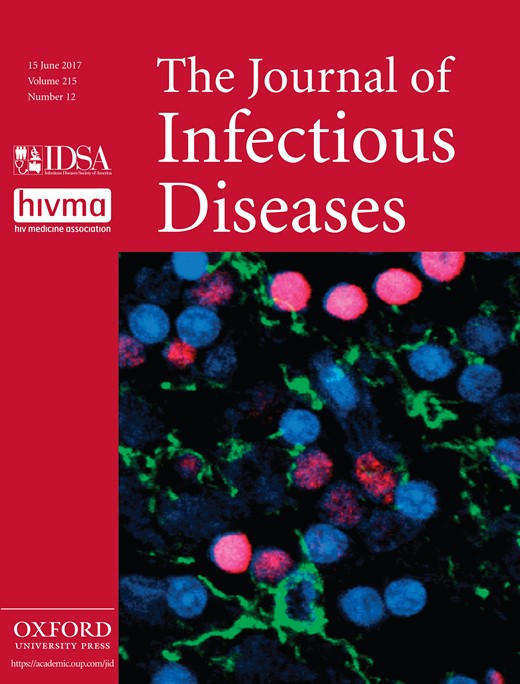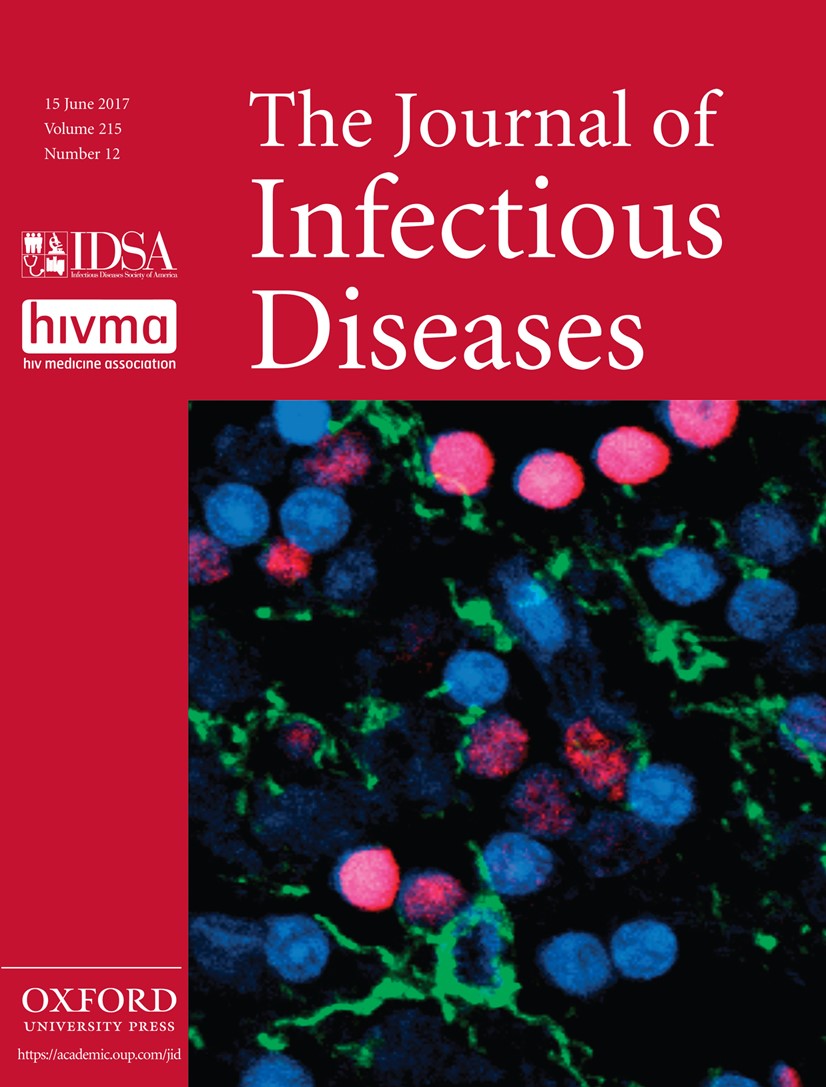
Cover image

Volume 215, Issue 12, 15 June 2017
EDITORIAL COMMENTARIES
Progress in Ebola Virus Vaccine Development
Targeting an Essential Component of Gram-Positive Type IV Secretion Systems Involved in Gene Transfer Kills 2 Birds With 1 Stone
Moving Lassa Fever Research and Care Into the 21st Century
REVIEW
The Doctrine of Original Antigenic Sin: Separating Good From Evil
MAJOR ARTICLES AND BRIEF REPORTS
VIRUSES
Six-Month Safety Data of Recombinant Vesicular Stomatitis Virus–Zaire Ebola Virus Envelope Glycoprotein Vaccine in a Phase 3 Double-Blind, Placebo-Controlled Randomized Study in Healthy Adults
Ebola Zaire vaccine was generally well-tolerated, with increased rates of injection-site and systemic adverse events (AEs) compared to placebo; no vaccine-related serious AEs or deaths occurred. These findings support the use of this vaccine in persons at risk for Ebola virus disease.
Development, Use, and Impact of a Global Laboratory Database During the 2014 Ebola Outbreak in West Africa
The usefulness and value of a multifunctional global laboratory database is far reaching, with uses including but not limited to informing local outbreak interventions, developing global outbreak response strategies, virtual biobanking, and disease forecasting.
Human Neutralizing Monoclonal Antibody Inhibition of Middle East Respiratory Syndrome Coronavirus Replication in the Common Marmoset
A human monoclonal antibody, MCA1, directly targeting the receptor-binding domain of Middle East respiratory syndrome coronavirus (MERS-CoV) S glycoprotein, was isolated from a human survivor. MCA1 highly neutralized MERS-CoV in vitro and completely inhibited viral replication in common marmosets.
Characterization of Dengue Virus Infections Among Febrile Children Clinically Diagnosed With a Non-Dengue Illness, Managua, Nicaragua
Antibody responses to dengue virus infections in patients clinically diagnosed with a non-dengue febrile illness differed from responses to classic dengue and were associated with viral load at presentation. These findings have important implications for dengue virus immunology and surveillance.
Immunization With a Subunit Hepatitis C Virus Vaccine Elicits Pan-Genotypic Neutralizing Antibodies and Intrahepatic T-Cell Responses in Nonhuman Primates
A prophylactic hepatitis C virus (HCV) vaccine is needed for global control of HCV infection. A soluble E2 vaccine was evaluated in this study in rhesus macaques and showed the capacity of inducing both cross-neutralizing antibodies and intrahepatic memory T-cell responses.
Concordance Between Anal and Oral Human Papillomavirus Infections Among Young Men Who have Sex With Men
BACTERIA
Targeting Type IV Secretion System Proteins to Combat Multidrug-Resistant Gram-positive Pathogens
The Surface Protein SdrF Mediates Staphylococcus epidermidis Adherence to Keratin
SdrF, a Staphylococcus epidermidis surface protein, was found to facilitate binding to keratins 1 and 10, human nasal epithelial cells, and neonatal human epithelial keratinocytes. SdrF may facilitate S. epidermidis adherence to skin surfaces.
Effect of Prepregnancy Pertussis Vaccination in Young Infants
Postpartum receipt of tetanus, diphtheria, and acellular pertussis (Tdap) vaccine significantly increases maternal antibody concentrations in consecutive infants, and blunting of the later-born siblings’ immune responses occurs, similar to the effect of Tdap vaccination during pregnancy.
PATHOGENESIS AND HOST RESPONSE
A Case of Human Lassa Virus Infection With Robust Acute T-Cell Activation and Long-Term Virus-Specific T-Cell Responses
A detailed characterization of the human immune response to Lassa virus infection reveals an association between virus clearance and interferon α, robust B- and T-cell activation during acute infection, and the generation of polyfunctional Lassa-specific T-cell responses.
Relationship Between Body Mass Index and Outcomes Among Hospitalized Patients With Community-Acquired Pneumonia
Children who were overweight or obese, particularly with asthma, had higher odds of intensive care admission or mechanical ventilation. There was no association between elevated BMI and severe outcomes in adults, however, underweight adults had longer hospital stay..
Suppressor Cell–Depleting Immunotherapy With Denileukin Diftitox is an Effective Host-Directed Therapy for Tuberculosis
Lower Levels of Cervicovaginal Tryptophan Are Associated With Natural Clearance of Chlamydia in Women
HIV/AIDS
Antiretroviral Therapy Containing HIV Protease Inhibitors Enhances Fracture Risk by Impairing Osteoblast Differentiation and Bone Quality
Kaposi’s Sarcoma–Associated Herpesvirus Infection of Neurons in HIV-Positive Patients
PARASITES
Effects of Aging on Parasite Biomass, Inflammation, Endothelial Activation, Microvascular Dysfunction and Disease Severity in Plasmodium knowlesi and Plasmodium falciparum Malaria
In populations pauci-immune to malaria, risk of severe malaria increases with age. In knowlesi malaria, systemic inflammation, endothelial activation, and microvascular dysfunction increase with age, independent of parasitemia, and may account for the greater severity of disease seen in older adults.
Parasites Causing Cerebral Falciparum Malaria Bind Multiple Endothelial Receptors and Express EPCR and ICAM-1-Binding PfEMP1
Cytoadhesion and var gene transcription profile of infected erythrocytes have been performed in pediatric malaria patients in Benin. The results support the notion that complementary receptor interactions of EPCR binding PfEMP1with ICAM-1 amplifies development of severe malaria symptoms.



